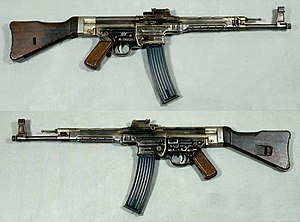Sturmgewehr 44
| Sturmgewehr 44 | |
|---|---|

StG 44 from the collections of the Swedish Army Museum
|
|
| Type | Assault rifle |
| Place of origin | Nazi Germany |
| Service history | |
| In service | 1943–1945 (Nazi Germany) 1949–1962 (East Germany) |
| Used by | See Users |
| Wars |
World War II Korean War Algerian War Vietnam War (Limited) Ogaden War (Limited) Iraq War Syrian Civil War |
| Production history | |
| Designer | Hugo Schmeisser |
| Designed | 1942 |
| Manufacturer | C. G. Haenel Waffen und Fahrradfabrik CITEFA (post war) Steyr-Daimler-Puch |
| Produced | 1943–1945 |
| Number built | 425,977 |
| Variants | MKb 42(H), MKb 42(W), MP 43, MP 43/1, MP 44 |
| Specifications | |
| Weight | 4.6 kg (10 lb) unloaded with magazine / 5.13 kg (11.3 lb) loaded |
| Length | 94 cm (37 in) |
| Barrel length | 42 cm (16.5 in) |
|
|
|
| Cartridge | 7.92×33mm Kurz, (aka. 8mm Kurz or Pistolenpatrone 43) |
| Action | Gas-operated, tilting bolt, full auto or semi-auto |
| Rate of fire | 550–600 rounds/min |
| Muzzle velocity | 685 m/s (2,247 ft/s) |
| Effective firing range | 300 m (automatic) 600 m (semi-automatic) |
| Feed system | 30-round detachable box magazine |
| Sights | Adjustable sights, rear: V-notch; front: hooded post |
The StG 44 (abbreviation of Sturmgewehr 44, "assault rifle 44") is a German selective-fire rifle developed during World War II. It is also known under the designations MP 43 and MP 44 (Maschinenpistole 43, Maschinenpistole 44 respectively).
The StG 44 was the first successful and widely produced design to use a new shorter cartridge, which permitted controllable automatic fire from a weapon more compact than a battle rifle, coupled with the recognition that most aimed rifle fire in combat situations did not exceed a few hundred metres.
By all accounts, the StG 44 fulfilled its role effectively, particularly on the Eastern Front, offering a greatly increased volume of fire compared to standard infantry rifles. However, it came too late to have a significant effect on the outcome of the war. Its lasting effect was its major impact on modern infantry small arms development, giving rise to an entire class of weapons borrowing the name assault rifle.
MP 43, MP 44, and StG 44 were different designations for what was essentially the same rifle with minor updates in production. The variety in nomenclatures resulted from the complicated bureaucracy in Nazi Germany. Developed from the Mkb 42(H) "machine carbine", the StG 44 combined the characteristics of a carbine, submachine gun, and automatic rifle. StG is an abbreviation of Sturmgewehr. According to one account, the name was chosen personally by Adolf Hitler for propaganda reasons and literally means "storm rifle" as in "to storm (i.e., assault) an enemy position", although some sources dispute that Hitler had much to do with coining the new name besides signing the order. After the adoption of the StG 44, the English translation "assault rifle" became the accepted designation for this type of infantry small arm. Over the course of its production, there were minor changes to the butt end, muzzle nut, shape of the front sight base and stepping of the barrel.
The rifle was chambered for the 7.92×33mm Kurz cartridge. This shorter version of the German standard (7.92×57mm) rifle round, in combination with the weapon's selective-fire design, provided a compromise between the controllable firepower of a submachine gun at close quarters with the accuracy and power of a Karabiner 98k bolt-action rifle at intermediate ranges. While the StG 44 had less range and power than the more powerful infantry rifles of the day, Army studies had shown that few combat engagements occurred at more than 300 metres (330 yd) and the majority within 200 metres (220 yd). Full-power rifle cartridges were excessive for the vast majority of uses for the average soldier. Only a trained specialist, such as a sniper, or soldiers equipped with machine guns, which fired multiple rounds at a known or suspected target, could make full use of the standard rifle round's range and power.
...
Wikipedia
